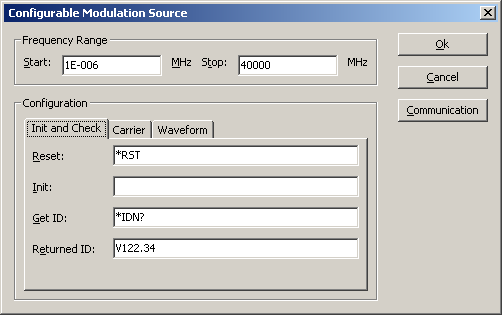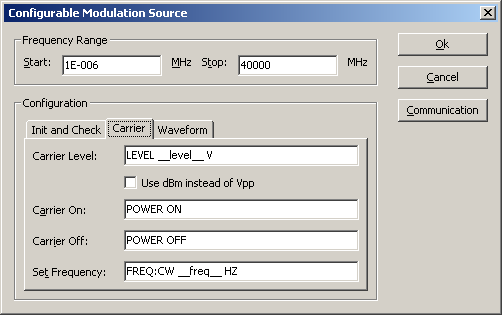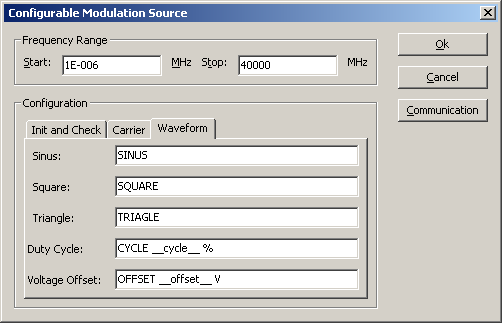Configurable Modulation Source
Jump to navigation
Jump to search
The Configurable Modulation Source device driver is a Modulation Source which is supported by RadiMation®.
Links
- Google search: Configurable Modulation Source
- Google image search: Configurable Modulation Source
| This information about an equipment is automatically generated from the list of supported device drivers from RadiMation. |
| If you need more information you can contact radimation-support@raditeq.com. |
| Command to be send to the device to reset the device. Leave blank if you do not want to reset the device. |
| Command to be send to the device to initialize the device. Leave blank if you do not want to initialize the device. |
| Command to be send to the device to get the identification from the device. Leave blank if you do not want to verify if the device is connected. If you do not use the verify, RadiMation® will not raise an error when a device is not connected during the initialization of a test. |
| The complete or a part of the return string from the device. The string is compared and when found the check will return that the device is connected. |
| The command that is send to the device to set the level. Because the command can contain more then just the value that needs to be send, a indicator is used. The indicator for the level is the code __carrier__.
Example: LEVEL __carrier__ V. and the level that needs to be send is 2 V. Will result in LEVEL 2 V |
| When selected the carrier level will be calculated from Vpp to Pdbm |
| The command that is send to turn on the carrier of the modulator. |
| The command that is send to turn off the carrier of the modulator. |
| The command that is send to the device to set the frequency. Because the command can contain more then just the value that needs to be send, a indicator is used. The indicator for the level is the code __freq__.
Example: FREQ:CW __freq__ HZ. and the frequency that needs to be send is 200 Hz. Will result in FREQ:CW 200 HZ. |
| The command that is send to the device to set the signal type to sinus. |
| The command that is send to the device to set the signal type to square. |
| The command that is send to the device to set the signal type to triangle. |
| The command that is send to the device to set the duty cycle. Because the command can contain more then just the value that needs to be send, a indicator is used. The indicator for the level is the code __cycle__.
Example: CYCLE __cycle__ %. and the duty cycle that needs to be send is 50%. Will result in LEVEL 50 % |
| The command that is send to the device to set the offset. Because the command can contain more then just the value that needs to be send, a indicator is used. The indicator for the offset is the code __offset__.
Example: OffSET __offset__ V. and the offset that needs to be send is 0.5V. Will result in LEVEL 0.5 % |


